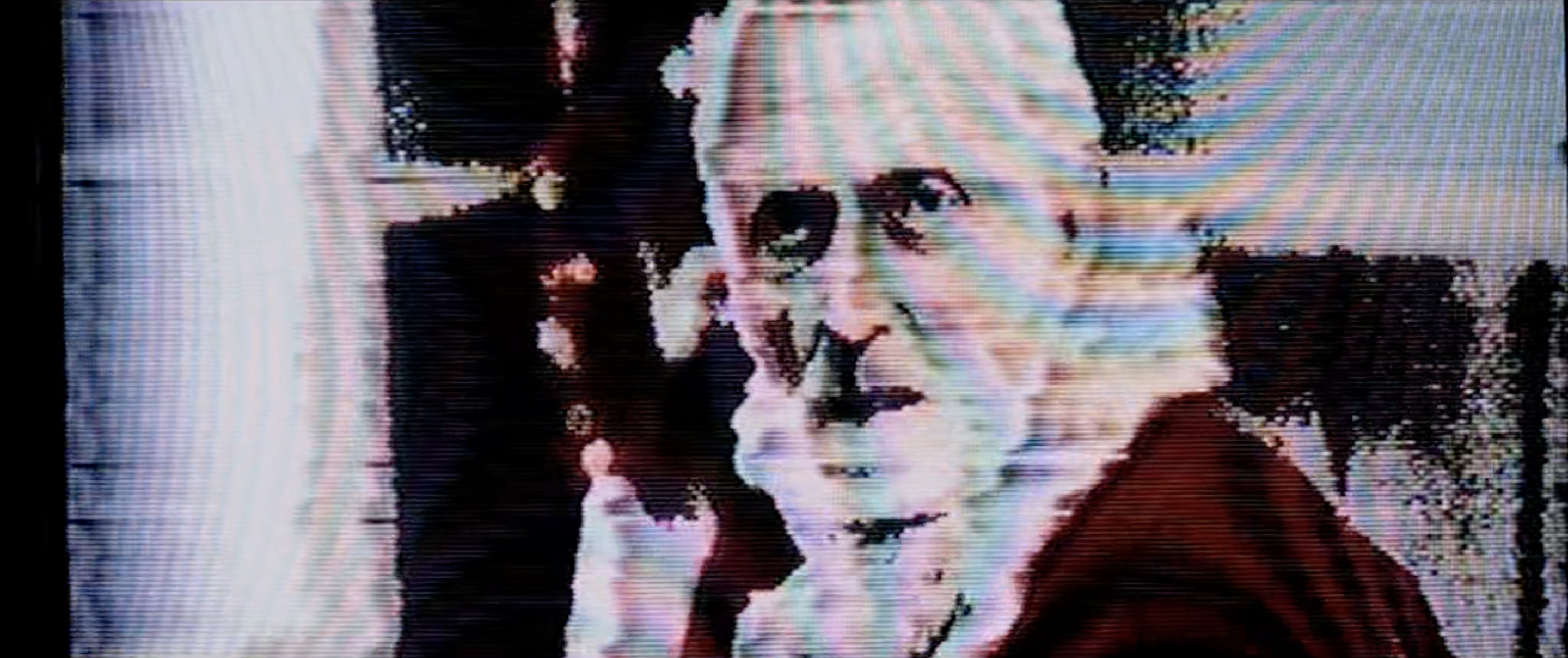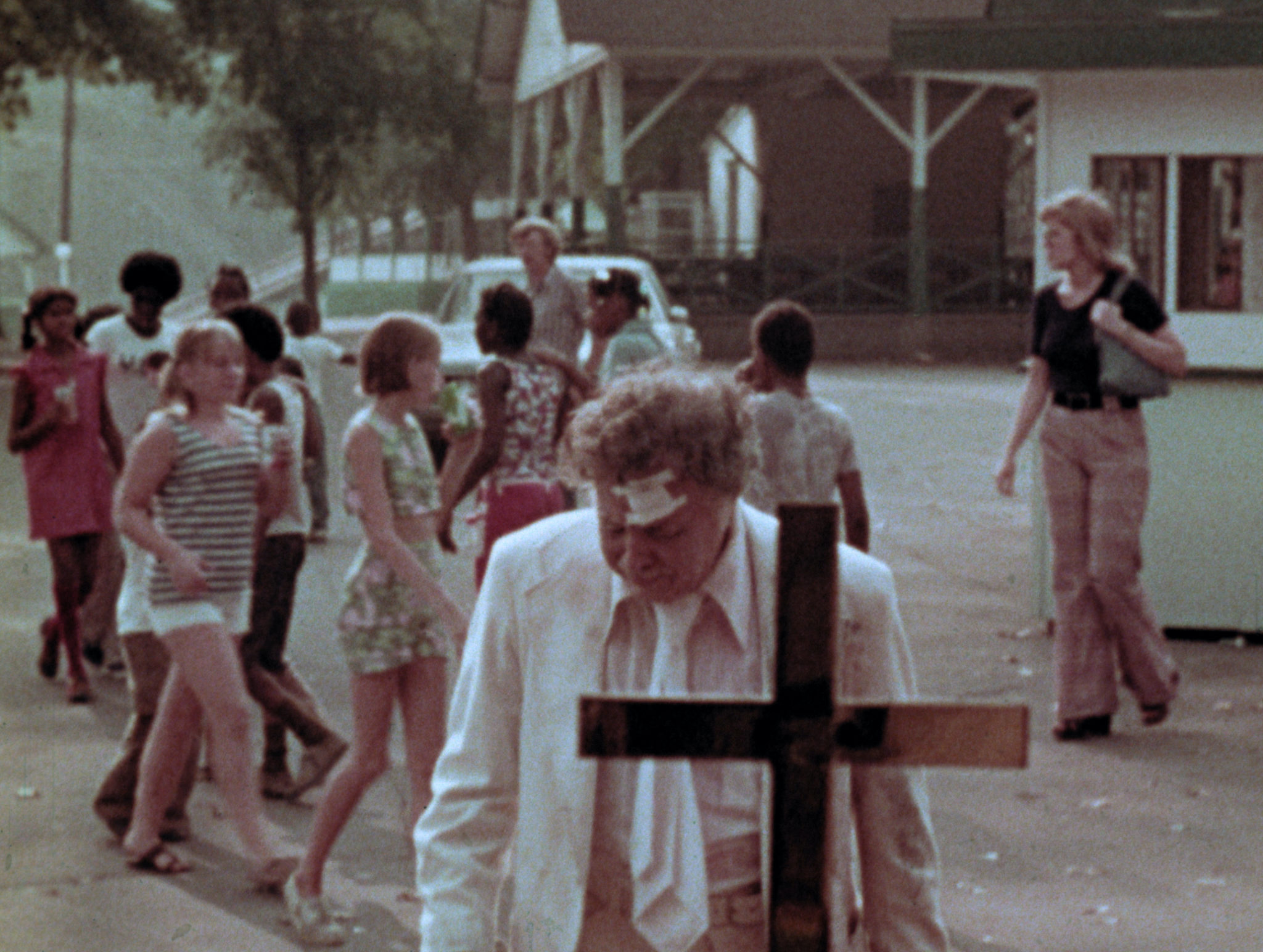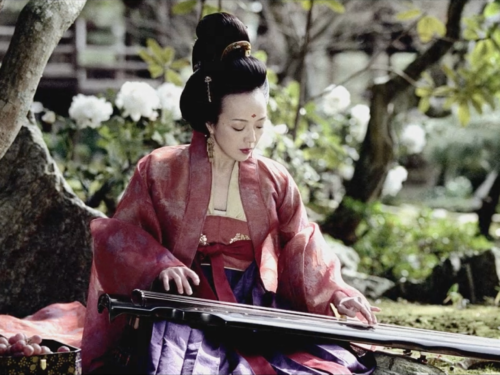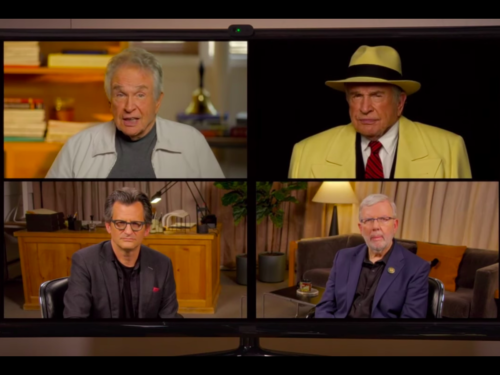Full of creeping dread and frayed family bonds, Lobo’s 2019 film is a cracked-mirror portrait of returning home for the holidays
In the classic Charles Beaumont-penned The Twilight Zone episode “The Howling Man” (1960), a bunch of monks, led by a grave John Carradine as Brother Jerome, claim to have the devil himself locked away in a prison cell in their castle. Thing is, the guy behind bars sounds pretty reasonable. And Brother Jerome, solemn and firm in his conviction as he may be, comes off as a bit of a crackpot. It certainly doesn’t help that he looks like he stepped out a Cecil B. DeMille religious epic, what with his Moses beard and Staff of Truth. Plus, c’mon, the devil?
As critic Zach Handlen pithily put it when recapping The Howling Man, “Believing in the devil means, for most of us, changing our entire concept of how reality works. That’s a tough sell.” But lo and behold, the self-appointed cult leader in the robes was dead on: when the man is freed from the cell, he transforms into a campy, cartoonish demon with horns, pointy ears, a sharp goatee, and a flamboyant cape. Score one for zealotry. Same deal in John Carpenter‘s Prince of Darkness (1987). Donald Pleasance, the horror maestro’s favorite lovable paranoiac, is eminently correct in assuming that the swirling goo he has quarantined in the church basement is the physical manifestation of satan. As in Halloween (1978), Pleasance is somehow both hysterical and the voice of reason.
Writer/director/editor Josh Lobo’s I Trapped the Devil jacks its premise of The Howling Man and draws clear inspiration from Prince of Darkness, but boils Satanic Panic down to just one guy’s nervous breakdown on Christmas Night. The film is a potent cocktail of Lobo’s fixations: late-aughts/early-’10s mumblegore — Ti West’s The House of the Devil (2009) sticks out, sharing two actors, A.J. Bowen and Jocelin Donahue — the illustrations of Glenn Chadbourne, the “cold tone” of Matt Reeves’ Let Me In (2010) and Roman Polanski’s The Ninth Gate (1999), Nine Inch Nails, BioShock, vintage Stephen King dust jackets, and, again, the circular storytelling of The Twilight Zone. All this coalesces to create a thick atmosphere, a movie that is mostly about texture and vibe deep shadows. It feels out of time, what with its patchwork of reference points and its prominently featured cathode ray TV. The movie starts out somber and mournful and sustains that feeling for the duration.

I Trapped the Devil contains a bite-size version of the cosmic conundrum at the heart of, say, The Exorcist (1973): the violent collision of modern logic versus ancient myth. The degree to which you read these stories as parables of faith depends on the beliefs you bring in. Ultimately, it’s the clash itself that is most compelling. And the Christmas setting is the bow on top. In the grand tradition of Christmas stories, I Trapped the Devil takes place over the course of a single fateful night around the holiday. The film is a home invasion thriller without any home invasion, a portrait of paranoia full of creeping dread and frayed family bonds. In other words, a classic Christmas tale. Matt (A.J. Bowen) and Karen (Susan Burke) show up unannounced at Matt’s brother Steve’s (Scott Poythress) house in time for the holiday. This is not exactly a cheerful visit — more of a wellness check.
Steve occupies what was once his and Matt’s family home. And it seems that it has been some time since the brothers have spoken or seen each other, probably years. Steve is cagey immediately. At first he tells them that they have to leave, but then he relents. The three share an awkward meal together. There are copious red flags. Steve is edgy and mostly silent, not responding to basic questions, making eye contact, or reacting to any of the details Matt and Karen are sharing about their lives. Plus there are shell casings in the snow outside and the phone keeps ringing. Of greater concern is the fact that there are newspapers covering all the windows. I Trapped the Devil only plays coy for so long. The central dilemma is right there in the title. Eventually, Steve pulls Matt aside and reveals his secret: there’s a man locked in the basement and he is convinced that he is the devil incarnate. He wants Matt and Karen to trust him on this. He needs them to believe.

Steve has been hard at work, you see, researching this evil for the last two years and he has arranged his research into a deranged, impenetrable, immersive art project. After the heated three-way, single-take debate about this situation by the Christmas tree ends in an ellipsis, Steve leads Matt to a side room and into a physical representation of his crumbling mind. All along the walls and ceiling of this room are the pieces of his investigation: newspaper clippings, macabre photography, and a dense web of red strings connecting the dots. It means everything and nothing all at once, the sprawling, conspiratorial ramblings of an unsound mind given a shape.
There are no answers to be found in this mountain of supposed evidence other than Steve’s escalating mental illness. At the same time, Karen heads down to the basement to discover more for herself. She comes away shaken by the feeling she gets from the man (Chris Sullivan), who addresses her by name and whose inflection turns quickly from pleading to sinister. The movie really operates as two distinct halves and pivots on these two scenes. As the movie turns, each character reorients their position to the central problem and the notion of belief: Matt sees his estranged brother’s obsession in all its glory, Steve is forced to step back and see his work through Matt’s eyes, and Karen undergoes a total conversion.
Related: Read Logan Ann Taylor’s appreciation of You’re Next (2011)
At its exact midpoint, I Trapped the Devil makes it clear that Steve is not of sound mind and that there is something unmistakably malevolent about the man locked behind the makeshift crucifix in the basement. It then devolves into a daisy chain of abstract symbolism and surreal episodes. The haze of Christmas ties all these contradictory realities together. The holidays have a way of reducing the world down to binaries — naughty and nice, good and evil, believers and non-believers — and I Trapped the Devil divides into halves that represent this dichotomy. The first part is riddled with doubt, skepticism, anxiety, and the real-world consequences of the situation at hand. The final stretch is defined by belief, acceptance, and acquiescence as madness takes hold.

Maybe once we enter Steve’s “mind,” we never leave. The phantasmagoria of the film’s second half could be the delusion and paranoid fantasies of an unwell man playing out to their illogical endgame. It could be his long-gestating psychotic break passing the tipping point. Of course, another way to see all this is through the prism of belief. I Trapped the Devil is essentially a chamber piece about coming home for the holidays. It’s about the past and the present overlapping and the ravages of time held in stark relief. It struggles with all the uncertainty and weight bundled in that premise. Holiday films often reflect the holiday season as a crucible of faith. They typically reinforce and validate cultural values with some once-specific, now-generalized religious connotation. During the holidays, murder spikes, crime spikes, depression spikes. It’s no wonder that god-fearing types would feel closer to their holy spirit as well as its antithesis this time of year.
Christmastime heightens the tension around differing, sometimes competing beliefs and values. Nonbelievers and the faithful interact more readily, secular and religious rituals and traditions overlap and blur. It’s a time of year when one is face-to-face with different viewpoints, where we’re consciously and unconsciously questioning and redefining how we see the world in relation to our friends, neighbors, and loved ones. Perhaps the best way to look at I Trapped the Devil is to indulge its desire to be both a portrait of mental illness during a season of widespread melancholy as well as a jaundiced yuletide parable about grappling with lapsed belief. What Steve has done in allegedly trapping the devil is enact some bastardized version of the spirit of the holidays.

This is the time of year where we are told, beseeched, pressured even, to spread joy and goodwill, express gratitude, heal, and reconnect with our better selves and loved ones, and to broadcast our actions. This year-end, last-ditch gauntlet of good intentions is cut with a healthy dose of fear and self-loathing — both essential elements in all our classic Christmas stories. There’s a superego in the shape of a man who lives at the top of the world and passes judgment from on high based on inscrutable criteria. A ghoulish Santa even appears in an unsettling still image in the static of the television screen late in the film. Holiday horror films just tend to bring these less-palatable elements closer to the surface. In his own way, Steve is trying to make the world a better place. He’s making a grand gesture, a dramatic overture to an uncaring, judgemental universe.
Is his rationale for his vigilantism — that this man is the manifestation of evil and thus he is negating this presence and its influence — an absurd overcompensation or a sincere expression of Christmastime heroism? At the very least, it’s made clear that his actions are compounded, if not undermined, by some unspecified grief, trauma, paranoia, and a rapidly deteriorating mental state. Lobo and director of photography Bryce Holden have an uncanny feel for holiday tableaus. Light diffuses through the rooms, bouncing off the dust particles in the air, accentuated by the nostalgic warmth of the film stock grain. The newspapers plastered over the windows blot out the natural light. Holden’s lensing makes vivid use of colored lighting gels, taking cues from Mario Bava’s Planet of the Vampires (1965), while the holiday decorations animate the gloomy mise en scène, juxtaposing merriment and menace, celebration and depression.

The sound design is diabolically hypnotic and narcotizing. It lures you in to listen closer. The evocative staging, realized by production designer Karleigh Engelbrecht and art director Sage Alice Griffin, does a lot of work to set the mood and shade the strained central relationship. Memories of Matt and Steve’s shared childhood line the shelves of the house. Some rooms are preserved and untouched, dust-covered toys marking the unspoken history of the place that seems both normal and not entirely pleasant. The two brothers sharing a drink in the glow of the Christmas tree is an especially effective portrait, reminiscent of the comedown after the excitement of the holiday. The kicker is Steve presenting Matt with the book The Devil in You: A Brief Philosophy of the Abyss, which explains his beliefs and actions. It’s a moment that is wryly comic — the title of the book is very tongue-in-cheek — but also heartbreakingly familiar for anyone who’s been ambushed by a relative who’s given themselves over to backward ideologies and conspiracy theories. “You listen to the news. You watch TV. Things are changing right before our eyes,” Steve rants. “We are on the precipice of something.”
I Trapped the Devil is attuned to the awkward interactions the holidays tend to create. It’s a cracked-mirror holiday portrait that’s deeply conflicted at its core. Sure, in the end, whoever or whatever was behind the door is released back into the world in the form of a little girl (Victoria Smith as Her) cheerfully skipping away from the crime scene and through the neighborhood. But the film has a subtle yet unmistakable tendency to backtrack, rationalize, and equivocate before diving into the deep end. The three characters’ convictions are confounding to the bitter end. Is Steve dangerous or isn’t he? Matt tells Karen both before they are eventually held at gunpoint. Karen transforms from sober realist to committed believer; she kills Steve and is the last line of defense when the cops arrive. And Steve seems wholly incapable of articulating how he came to his target, and what he intends to do next.

In most Christmas movies there’s a twinge to recapture something lost or forgotten from one’s youth. The atmosphere of misanthropy and regret is so suffocating in I Trapped the Devil, and the memories so faded, it makes you wonder if those happier, simpler times ever existed at all. Even with his mind teetering on the edge of the abyss, Steve has taken care to trim the Christmas tree. He’s strung lights along the outside of the house and the big tree that stands next to the entranceway. The decorations are seemingly a reflex, arranged in accordance with a phantom cultural memory. As the film’s stark poster indicates — with its towering, stylized “I” — subjectivity is key to unlocking what the film is after and what it has to say about its chosen holiday. “The man behind that door might be the devil to you,” Matt derides Steve before his fratricide. “But he is for sure not the devil.” Depending on how you look at it, at Christmastime, family is either a joy to cherish or a heavy burden to endure. I Trapped the Devil is intent on having its devil’s food cake and eating it, too; it comes down on the side of absurdity while stacking the deck with insanity.
Stay up to date with all things Split Tooth Media and follow Oliver on Twitter
(Split Tooth may earn a commission from purchases made through affiliate links on our site.)




